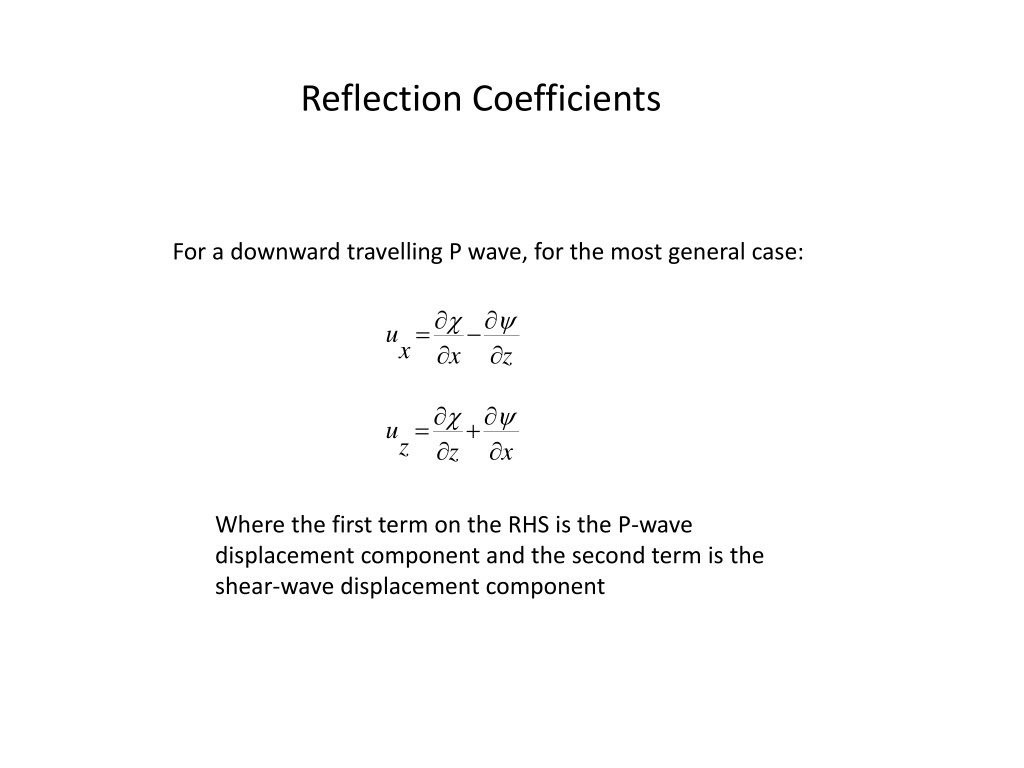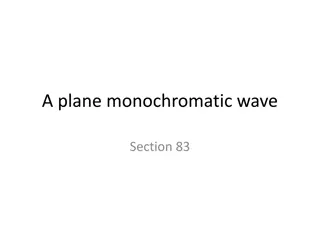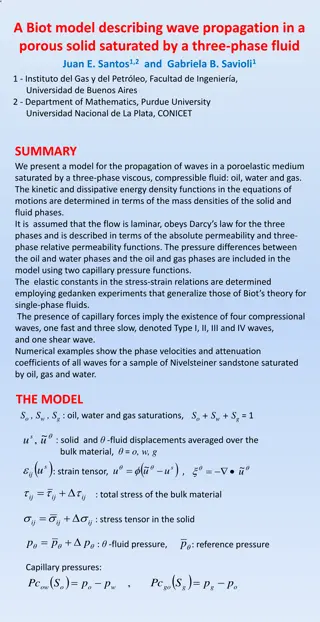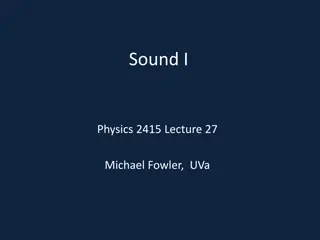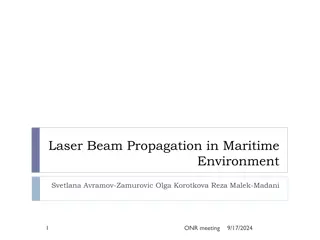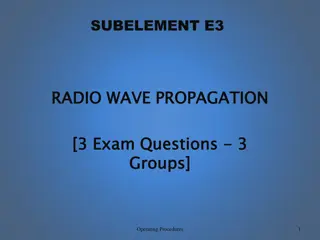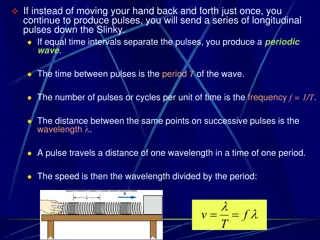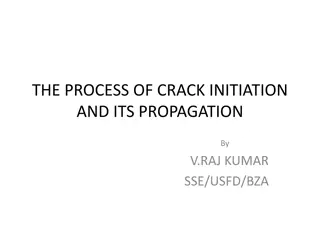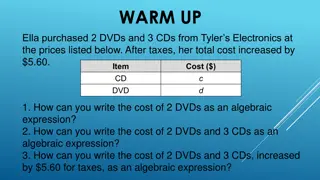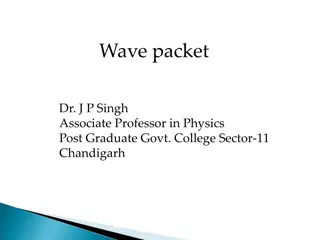Understanding Reflection Coefficients in Wave Propagation
Reflection coefficients play a crucial role in wave propagation, particularly for P and shear waves. The equations governing reflection coefficients provide insight into wave behavior at boundaries and interfaces. By examining the conditions and special cases, we can understand how these coefficients impact wave interactions, such as complete reflections with phase shifts.
Download Presentation

Please find below an Image/Link to download the presentation.
The content on the website is provided AS IS for your information and personal use only. It may not be sold, licensed, or shared on other websites without obtaining consent from the author. Download presentation by click this link. If you encounter any issues during the download, it is possible that the publisher has removed the file from their server.
E N D
Presentation Transcript
Reflection Coefficients For a downward travelling P wave, for the most general case: = ux x z = + uz z x Where the first term on the RHS is the P-wave displacement component and the second term is the shear-wave displacement component
Reflection Coefficients and where both shear stress, 2 2 2 1 2 = + (2 ) xz 2 2 x z x z and as well as normal stress is continuous across the boundary: 2 2 2 = + 2 (2 + ) zz 2 x z z
Reflection Coefficients When all these conditions are met and for the special case of normal incident conditions, we have that Zoeppritz s equations are: + V V + 2 2 1 1 I I I I P P 2 2 1 1 2 2 1 1 = = R V V / P P P P \ 2 V + 2 2 1 I + P 1 1 1 = = T I I V V \ P P 1 2 P P \ 2 1 On occasions these equations will not add up to what you might expect !
Reflection Coefficients + 2 2 I I I I I + 2 2 1 1 1 + = + R T I I / \ P P P P 1 \ \ + 2 1 I I I I 2 1 + 1 = I 2
Reflection Coefficients + 2 I I I I I + 2 2 1 1 1 + = + R T I I / \ P P P P 2 1 \ \ + 2 1 I I I I 2 1 + 1 = I + + 2 I I I I 2 2 1 1 =
Reflection Coefficients + 2 2 I I I I I + 2 2 1 1 1 + = + R T I I / \ P P P P 1 \ \ + 2 1 I I I I 2 1 + 1 = I + + 2 I I I I 2 2 1 1 = = 1
Reflection Coefficients + 2 I I I I I + 2 2 1 1 1 + = + R T I I / \ P P P P 2 1 \ \ + 2 I I I 2 1 + 1 = I + + I 2 1 I I I I 2 2 1 1 = = 1 + = 1 R T / \ P P P P \ \
Reflection Coefficients + 2 I I I I I + 2 2 1 1 1 + = + R T I I / \ P P P P 2 1 \ \ + 2 I I I 2 1 + 1 = I + + I 2 1 I I I I 2 2 1 1 = = 1 + = 1 R T / \ P P P P \ \
Reflection Coefficients What happens when we have a complete reflection with a 180 degree phase shift, as we might have when a ray in water travels upward toward a free surface and reflects completely at the interface?
Reflection Coefficients What happens when we have a complete reflection with a 180 degree phase shift, as we might have when a ray in water travels upward toward a free surface and reflects completely at the interface? We know that in this case: = 1 R / P P \
Reflection Coefficients What happens when we have a complete reflection with a 180 degree phase shift, as we might have when a ray in water travels upward toward a free surface and reflects completely at the interface? We know that in this case: = 1 R / P P \ + = 1 R T But, / \ P P P P \ \ = ? T What must: \ P P \
Reflection Coefficients What happens when we have a complete reflection with a 180 degree phase shift, as we might have when a ray in water travels upward toward a free surface and reflects completely at the interface? We know that in this case: = 1 R / P P \ + = 1 R T But, / \ P P P P \ \ = 2 T So, \ P P \
Reflection Coefficients Briefly, how to consider displacements at interfaces using potentials, when mode conversion occurs: Z- layer 1 X+ layer 2 Z+ In layer 1, just above the boundary, at the point of incidence: \ / \ / \ \ S P S z = + P x P P x ux z
Reflection Coefficients Briefly, how to consider displacements at interfaces using potentials, when mode conversion occurs: Z- layer 1 X+ layer 2 Z+ In layer 2, just below the boundary, at the point of incidence: \ \ \ \ = P P z ux P S x
Reflection Coefficients So, if we consider that (1) stresses as well as (2) displacements are the same at the point of incidence whether we are in the top or bottom layer the following must hold true so that (3) Snell s Law holds true: + = , u u x x + = u u z z + = = zz zz + zx zx
Reflection Coefficients We get the general case of all the different types of reflection and transmission (refraction or not) coefficients at all angles of incidence : = RP P RP S T P P T P S sin cos \ \ \ P cos \ / \ P sin2 \ \ \ P cos2 \ \ \ P
Reflection Coefficients Variation of Amplitude with angle ( AVA ) for the fluid-over-fluid case (NO SHEAR WAVES) 2 sin V V cos 1 I I 2 2 1 1 ( ) = R 2 sin V V + cos 1 I I 2 2 1 1 (Liner, 2004; Eq. 3.29, p.68; ~Ikelle and Amundsen, 2005, p. 94)
Reflection Coefficients What occurs at and beyond the critical angle? V V sin sin2 = c 1 2 V V = 1 sin 1 2 c
Reflection Coefficients FLUID-FLUID case What occurs at the critical angle? 2 sin V V cos 1 I I 2 2 1 1 ( ) = R 2 sin V V + cos 1 I I 2 2 1 1 (Liner, 2004; Eq. 3.29, p.68; ~Ikelle and Amundsen, 2005, p.94)
Reflection Coefficients Reflection Coefficients at all angles: pre- and post-critical Case: Rho: 2.2 /1.8 V: 1800/2500 Matlab Code
NOTES: #1 Reflection Coefficients At the critical angle, the real portion of the RC goes to 1. But, beyond it drops. This does not mean that the energy is dropping. Remember that the RC is complex and has two terms. For an estimation of energy you would need to look at the square of the amplitude. To calculate the amplitude we include both the imaginary and real portions of the RC.
NOTES: #2 Reflection Coefficients For the critical ray, amplitude is maximum (=1) at critical angle. Post-critical angles also have a maximum amplitude because all the energy is coming back as a reflected wave and no energy is getting into the lower layer
NOTES: #3 Reflection Coefficients Post-critical angle rays will experience a phase shift, that is the shape of the signal will change.
Energy Coefficients + = 1 R T We saw that for reflection coefficients : / \ P P P P \ \ = E RP P \ / \ / P P For the energy coefficients at normal incidence : VP V P 2 11 2 = E TP P \ / \ \ P P
Energy Coefficients + = 1 R T We saw that for reflection coefficients : / \ P P P P \ \ = E RP P \ / \ / P P For the energy coefficients at normal incidence : VP V P 2 11 2 = E TP P \ / \ \ P P The sum of the energy is expected to be conserved across the boundary = + + + E E E E E \ \ / \ / \ \ \ \ P P P P S P P P S
Amplitude versus Offset (AVO) Zoeppritz s equations can be simplified if we assume that the following ratios are much smaller than 1: VS VP average VPaverage VSaverage For example, the change in velocities across a boundary is very small when compared to the average velocities across the boundary; in other words when velocity variations occur in small increments across boundaries This is the ASSUMPTION
Amplitude versus Offset (AVO) If the changes across boundaries are relatively small, then we can make a lot of approximations to simplify the reflection and transmission coefficients: 2 S 2 V 1 2 V 1 2 z P 2 = + sin R 2 Paverage \ / i average V z P V P P average ( Equation, 3.242, Ikelle and Amundsen)
AVO cases for P-P In addition, we can rearrange and further simplify this equation as follows: ??? = ??? ?????? ????????;= 0 + 4.5 ????? ??????? ? ????? ??? 0 sin ? ??? sin(? ???) ( Equation, 3.255, Ikelle and Amundsen)
AVO cases for P-P With the much simplified calculation for reflection coefficients, we can characterize reservoirs according to the Rpp at normal incidence ( intercept) and contrast in Poisson s ratio across their boundaries (~gradient or slope): CLASS 1 (Z1<Z2) CLASS 1 (Z1<Z2) slope CLASS 1 (Z1<Z2) intercept
AVO cases for P-P-CLASS 2 Class 2 shows very little contrast between layer properties slope CLASS 2 Z1~Z2 intercept
AVO cases for P-P-CLASS 3 Class 3 shows the characteristic bright spot that is often interpreted to mean shale over gas sand (Z1<Z2). The reflection coefficient becomes more negative with offset slope CLASS 3 Z1<Z2 intercept
AVO cases for P-P-CLASS 4 Class 4 is like class 3 in that there is a strong negative reflection BUT the Reflection coefficient decreases with angle (GOM) CLASS 4 Z1<Z2 slope CLASS 4 Z1<Z2 intercept
